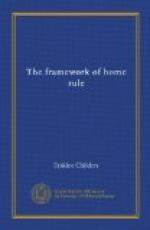Turn back to Ireland and weigh well the analogy. Mutatis mutandis, almost every paragraph of the Durham Report applied with greater force to the Ireland of his day. The ascendancy of a caste and creed minority in Upper Canada; of a race minority in Lower Canada; “the conflict of races, not of principles”; the consequent obliteration of natural political divisions, and the substitution of unnatural and vindictive antagonisms demoralizing both sides to every quarrel; the universal disgust with and distrust of the British Government, though for reasons diametrically opposite; the hopelessness of true reforms; the perpetuation of abuses; the stagnation of trade and agriculture; the re-emigration to America, and the abuses of a Church Establishment with endowments from sources by right public—all these phenomena and many others had their counterpart in Ireland. Some have disappeared. The Church is disestablished. The land question is on the way to settlement. The old ascendancy is mitigated. But many of the political, and all the psychological, features of the situation which Durham described do, alas! exist to-day in Ireland. Ireland, like the Canada of 1838, is a land of bewildering paradox. There is a similarly unwholesome arrest of free political life, the same unnatural division of parties, the same suppression of moderate opinion, and the same inevitable maintenance of a Home Rule agitation, harmful in itself, because it retards the country and accentuates for the time being the very divisions it seeks to cure, but absolutely necessary for the final salvation of Ireland. Durham, in the case of Canada, saw the truth, and swept into the limbo of discredited bogies the old figments of the coercionists. In a singularly noble and profound passage (p. 229), revealing the ethical basis on which his philosophy rested, he declared that even if the political freedom of the Colony were to lead in the distant future to her separation from the Empire, she nevertheless had an indefeasible moral right to the blessings of freedom; but he prophesied correctly that the connection with the Empire “would only become more durable and advantageous by having more of equality, of freedom, and of local administration.”




